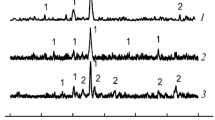Abstract—
The acid-base properties of cobalt ferrite synthesized by the mechanochemical method with different ratios of the main components Fe2O3 : Co3O4 have been investigated using the temperature-programmed desorption of ammonia, IR spectroscopy using adsorbed pyridine with ammonia, and the Hammett indicator method. A comparison of the results for the total content of Lewis and Brønsted acid sites by three methods has shown that all three samples were quite similar, with a probability of 0.5%. The introduction of cobalt oxide into the composition of cobalt ferrite leads to an increase in the concentration of Brønsted and Lewis centers with a simultaneous increase in the number of strong basic centers determined by the temperature-programmed desorption of ammonia. The indicator method is the most informative method for a quantitative study of the acid-base properties of the cobalt ferrite surface, since it allows one to assess the concentration and strength of Lewis and Brønsted acid sites and basic sites.




Similar content being viewed by others
REFERENCES
Ermolovich, E.A., Effect of grinding on the donor-acceptor properties of surfaces of backfill mix components, J. Min. Sci., 2013, vol. 49, no. 5, pp. 839–846. https://doi.org/10.1134/S1062739149050195
Busca, G., Onida, B., Tichit, D., and Vaccari, A., Catalysis by acids and bases: New materials and surface studies: ABC-6, 6th World Congress on Catalysis by Acids and Bases, Genova (Italy), May 10–14, 2009, Catal. Today, 2010, vol. 152, nos. 1–4, p. 1. https://doi.org/10.1016/S0920-5861(10)00343-3
Vredrine, J.C., The role of redox, acid–base and collective properties and the crystalline state of heterogeneous catalysts in the selective oxidation reactions, Top. Catal., 2002, vol. 21, p. 97.
Fechete, I., Wang, Y., and Vredrine, J.C., The past, present and future of heterogeneous catalysis, Catal. Today, 2012, vol. 189, p. 2.
Isupova, L.A., Tsybulya, S.V., Kryukova, G.N., Budneva, A.A., Paukshtis, E.A., Litvak, G.S., Ivanov, V.P., Kolomiichuk, V.N., Pavlyukhin, Yu.T., and Sadykov, V.A., Mechanochemical synthesis and catalytic properties of calcium ferrite—Ca2Fe2O5, Kinet. Catal., 2002, vol. 43, no. 1, p. 122.
Romanova, R.G., Lamberov, A.A., Gil’manov, Kh.Kh., and Gil’mullin, R.R., Acid–base properties of the surface of bimetallic dehydrogenation catalysts, Vestn. Kazan. Tekhnol. Univ., 2010, no. 5, pp. 74–82.
Sitnikov, P.A., Kuchin A.V., Ryazanov, M.A., Belykh, A.G., Vaseneva, I.N., Fedoseev, M.S., and Tereshatov, V.V., Influence of acid-base properties of oxides surface on their reactivity towards epoxy compounds, Russ. J. Gen. Chem., 2014, vol. 84, pp. 810–815. https://doi.org/10.1134/S107036321405003X
Lauren-Pernot, H., Evaluation of surface acid-basic properties of inorganic-based solids by model catalytic alcohol reaction networks, Catalyst, 2006, vol. 48, p. 315.
Tanabe, K., Solid Acids and Bases: Their Catalytic Properties, New York: Academic, 1970.
Nikitenkov, N.N., Osnovy analiza poverkhnosti tverdykh tel metodami atomnoi fiziki (Fundamentals of an Analysis of the Surface of Solids by the Methods of Atomic Physics), Tomsk: Tomsk. Politekh. Univ., 2013.
Smith, A.L., Applied Infrared Spectroscopy: Fundamentals, Techniques, and Analytical Problem-Solving, Chemical Analysis: A Series of Monographs on Analytical Chemistry and Its Applications, New York: Wiley, 1979.
Nechiporenko, A.P., Burenina, T.A., and Kol’tsov, S.I., Indicator method for studying the surface acidity of solids, Zh. Obshch. Khim., 1985, vol. 55, no. 9, pp. 1907–1912.
Zakharova, N.V. and Sychev, M.M., Evolution of donor–acceptor centers of the surface of ferroelectrics upon dispersion, Kondens. Sredy Mezhfaznye Granitsy, 2010, no. 1, pp. 56–62.
Romanova, R.G. and Petrova, E.V., Acid-base surface properties of binary systems based on aluminum and zirconium oxides, Kinet. Catal., 2006, vol. 47, no. 1, p. 138.
Glazneva, T.S., Kotsarenko, N.S., and Paukshtis, E.A., Acid-base surface properties of oxide catalysts: From the study of aqueous suspensions to in-situ studies, Kinet. Catal., 2008, vol. 49, no. 6, p. 859.
Tkhyui, D.M. and Mikhalenko, I.I., Pyridine adsorption for probing electron-acceptor sites on the surface of titanium oxide with supported silver, copper, and gold ions, Prot. Met. Phys. Chem. Surf., 2015, vol. 51, no. 6, p. 934.
Il’in, A.P., Smirnov, N.N., and Il’in, A.A., Development of a catalyst for medium-temperature conversion of carbon monoxide in ammonia production, Ross. Khim. Zh., 2006, vol. 60, no. 3, p. 84.
Manova, E., Paneva, D., Kunev, B., Estournès, C., Rivière, E., Tenchev, K., Léaustic, A., and Mitov, I., Mechanochemical synthesis and characterization of nanodimensional iron–cobalt spinel oxides, J. Alloys Compd., 2009, vol. 485, nos. 1–2, p. 356.
Guido, E.S. and Giaime, M.D., Mechanochemical route for the synthesis of cobalt ferrite–silica and iron–cobalt alloy–silica nanocomposites, J. Nanopart. Res., 2004, no. 6, p. 99.
Vasyutin, O.A., Study of the effect of synthesis conditions on the adsorption properties of spinel-type ferrite and the surface characteristics of garnet-type ferrite of yttrium by potentiometry and wetting methods, Extended Abstract of Cand. Sci. (Chem.) Dissertation, St. Petersburg, 2012.
Paukshtis, E.A. and Yurchenko, E.N., Study of the acid–base properties of heterogeneous catalysts by infrared spectroscopy, Russ. Chem. Rev., 1983, vol. 52, no. 3, p. 242.
Muradova, P.A., Zul’fugarova, S.M., Shakunova, N.V., Litvishkov, Yu.N., Tret’yakov, V.F., and Talyshinskii, R.M., The acidic properties of the surface of aluminum-reinforced alumina supports produced in a microwave field, Neftegazokhimiya, 2012, vol. 6, no. 2, p. 52.
Ivanovskaya, M.I., Tolstik, A.I., Kotsikau, D.A., and Pankov, V.V., The structural characteristics of Zn–Mn ferrite synthesized by spray pyrolysis, Russ. J. Phys. Chem. A, 2009, vol. 83, no. 12, p. 2081.
ACKNOWLEDGMENTS
We thank the Centre for Collective Use at the Ivanovo State University of Chemistry and Technology for providing access to equipment facilities.
Funding
This work was performed within the work plan of the laboratory for the synthesis, investigation, and testing of catalytic and adsorption systems for processing hydrocarbon raw materials (founded with financial support from the Ministry of Education and Science of the Russian Federation for 2012–2022, project no. FZZW-2020-0010). The theoretical part of the work was financially supported by the Scholarship of the President of the Russian Federation (grant no. SP-3800.2019.1).
Author information
Authors and Affiliations
Corresponding author
Additional information
Translated by D. Kharitonov
Rights and permissions
About this article
Cite this article
Denisova, K.O., Il’in, A.A., Rumyantsev, R.N. et al. Acid-Base Properties of Cobalt Ferrite Surface Examined by Different Physicoсhemical Methods. Theor Found Chem Eng 54, 1306–1313 (2020). https://doi.org/10.1134/S0040579520050309
Received:
Revised:
Accepted:
Published:
Issue Date:
DOI: https://doi.org/10.1134/S0040579520050309




